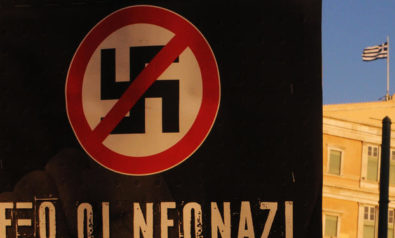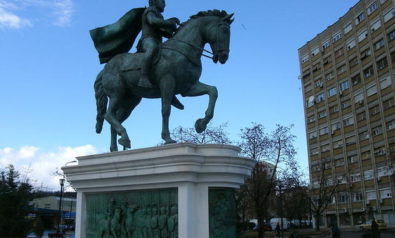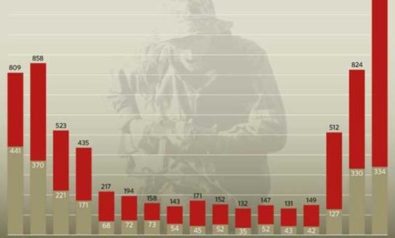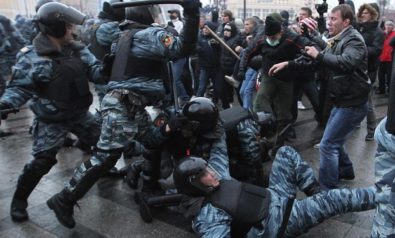While governments spend more time and funding on countering Islamic extremism, Europe faces an increasing threat from domestic extremist groups – both right- and left-wing – that are active in every country examined by the Athena Institute.
After the 9/11 attacks, international terrorism became the bogeyman of the West, something that lurks in the dark and waits for the right time to strike. This fear was not unfounded. The first decade of the 21st century was dominated by Jihadi terrorism: Kuta, New York, Madrid, London. Islamist terror groups became the first priority to secret services and other authorities. The aforementioned attacks shocked the West and started an avalanche of counter-terrorist legislations, not to mention the wars in Afghanistan and Iraq.
Whilst one cannot argue that international state-funded terrorism is not a threat anymore, the awesome amount of resources, expertise and money that have gone into the War on Terror was fairly successful. Since the 2005 London bombings, no large-scale Islamist terrorist incident has been carried out on Western soil. Nevertheless, international terrorism is still on the top of the threat-pyramid, followed by domestic extremism and general crime. However, a chain of recent events and new research indicates that this attitude towards far right and far left extremist groups must change – the sooner the better.
Game Changers
There have been several strong signs in the past few years that show that fighting domestic extremism should be a top priority for politicians, pundits and authorities on both sides of the Atlantic.
In Europe, the so-called Malmö sniper targeted members of ethnic communities. He killed one person and wounded several others. A German extremist cell operated for more than a decade robbing banks, killing nine immigrants and a policewoman. The Roma serial killers in Hungary killed six people of Roma origins and wounded several others in 2008 and 2009, keeping the whole Hungarian Roma community in terror for months. And finally Anders Behring Breivik, an extremist whose name will not be easily forgotten after the bombing of the government quarter in Oslo and the killing spree on Utoya Island that took 77 lives, most of them teenagers.
However, it is not only the far-right that threatens good governance and the safety of EU citizens. Several far-left groups carry out symbolic or even deadly attacks around Europe. The Nuove Brigate Rosse killed two government advisers between 1999 and 2002 and carried out a letter bombing campaign in 2007, amongst other attacks. The Federazione Anarchica Informale also carried out several attacks between 2009 and 2012 against embassies and regional tax offices. In Greece, several anarchist and communist extremist groups, like Zero Tolerance, the Informal Anarchist Federation or the Revolution First and Always all carry out attacks on a regular basis. These mainly involve firebombing of bank branches, police cars and other symbolic targets.
These are the most violent groups, and the most sombre and violent cases of extremist terror incidents on the continent that show that domestic extremism is not something to be taken lightly. It should be handled on the same level as international terrorism, as a threat to national security to be seriously reckoned with.
More than a 100
The Athena Institute conducted extensive research in thirteen European countries that mapped all active domestic extremist groups that score 4 or higher on the FBI’s Seven-Stage Hate Model (SSHM). On this scale 4 is symbolic violence (e.g. speech acts, hostile propaganda), 5 implies physical violence, 6 is physical violence amplified by the use of weapons and 7 indicates murder.
In the examined thirteen countries we identified more than 100 far-left or far-right extremist groups. Almost half of these groups (48%) score 4 on the SSHM scale, in other words they incite racial hatred and carry out permanent hostile propaganda campaigns against minority communities. The other half scores between 5 and 7 on the scale, ergo they use violence, weapons and even kill their supposed enemies. Out of the 115 identified groups 26 use violence amplified by use of weapons and “only” four have committed murder.
This stems from the fact that after a group killed or committed mass atrocities authorities will act. This is the reason why there are only a handful of groups with high threat levels, while this also highlights the fact that most groups that intent to kill are organized covertly (obviously the Institute does not monitor covert groups). On the other hand, this also means that while the most notorious groups are blocked or dismantled by law enforcement and justice systems, they are blocked or dismantled after they have killed, thus the damage has been done.
Their membership numbers are very varied, and there are only a few groups that have more than 500 members. Most of the groups have a couple of dozen of members or a few hundred.
Still, there are no countries without extremist groups within the thirteen countries the Athena Institute scrutinised.
Ignorance is not Bliss
Due to the nature of extremist groups many politicians in the mainstream political arena assume that, even though extremism poses a threat, that threat is not too serious. The membership numbers of the groups are fairly low, their activity is mostly about spreading hate speech on the internet and organising small protests. They are also poorly funded and mostly loosely organised.
These factors prompt people to believe that domestic extremist groups are simply incapable of doing serious harm or affecting society and mainstream politics in any substantial way. However, the aforementioned examples have proven that extremists can and do cause serious harm, but it also has to be highlighted that extremist groups cause harm and affect mainstream politics in much more subtle ways too.
The first thing that must be discussed is the ability of such groups to adapt and evolve as needed. With the changes in mass communication and the boom of social media, it has become much easier and much cheaper to deliver messages on the “dangers” of immigration, Islamisation, homosexuality or criminality to large audiences, not just locally, but globally. Extremist groups utilise these opportunities to the fullest. Of the groups identified by the Athena Institute, 86% use the internet to spread their propaganda and extremist ideas. They have their own websites, Twitter accounts, Facebook pages, blogs, forums, YouTube videos, etc.
Extremist groups use these channels to reify and redefine socioeconomic and cultural issues that necessarily emerge from modern multicultural/multi-ethnic/poly-religious societies as racial issues that threaten the majority or part of the majority. In other words they securitise certain issues (immigration, Islam, homosexuality, criminality, the Roma, etc.); they take a problem like immigration and turn it into a question of security by bombarding their ever more receptive audience with speech acts about how these issues threaten the Western way of life.
Hate groups are able to distort the mainstream political process via the above mentioned practices. They are able to tilt the whole political spectrum towards the extreme by the radicalisation of the mainstream parties’ electorate. These processes can lead to new standpoints, such as Angela Merkel’s speech about the failure of multiculturalism, that was followed by other leaders like David Cameron and Nicolas Sarkozy; or policies that are clearly anti-democratic, such as the banning of the burqa in public places in France, Switzerland banning the construction of new minarets, or the policies in Hungary, where the government handles socioeconomic issues surrounding the Roma community as an issue of policing.
However, there is a much more direct way through which extremists affect mainstream politics, and that is their stronger or looser ties to political parties, some of which have MPs or even MEPs. According to our findings, one third of the identified groups has some kind of ties to far-right or far-left parties. Sometimes these ties are very loose and only involve given groups open support for a party, but sometimes these ties can be very strong.
For example, in Hungary the far-right anti-Roma, anti-Semitic Jobbik party has 47 seats in Parliament, making it the third biggest faction. This party founded the Hungarian Guard extremist group and the New Hungarian Guard after the first one was disbanded and banned by the Hungarian courts. Furthermore, one of their MPs is the vice-president of the Sixty-four Counties Youth Movement (SfCYM), another highly active extremist group. The president of SfCYM has very strong ties to the leader of the Outlaws’ Army – a violent hate group – and so on and so forth.
In Greece, the Golden Dawn (GD) is the fifth biggest party in Parliament right now, but experts project that they can become the third largest faction after the next elections. Several Greek far-right extremist groups strongly support GD, whose sympathisers and MPs regularly harass and intimidate immigrant shopkeepers and vendors.
The Greek government’s reaction to the growing popularity of GD was a large scale crackdown on illegal immigrants, whilst, according to Human Rights Watch and Amnesty International, racially aggravated assaults have become commonplace in the country and the police turn a blind eye to these incidents more often than not.
If we step outside Europe for a moment, the anti-Muslim propaganda film the ‘Innocence of Muslims’ is also a great example for how non-violent extremists can cause turmoil and havoc in a whole region if the necessary circumstances are in place. In this case, the incident led to the death of the US ambassador to Libya in Benghazi and several other US foreign officials.
The Lone Wolf
Following violent extremist attacks, and especially after the attacks by Breivik in Norway, extremist groups, websites and blogs are very swift to distance themselves from the perpetrator, even though their ideas are arguably identical. These groups try to portray such extremists as lone wolves, who have nothing to do with them. Since several of these violent offenders have no formal ties to extremist groups and acted seemingly alone or in small isolated groups, many politicians and pundits identify them the same way.
This type of characterisation is grossly misleading, because it ignores (online) radicalisation and the ties these extremists had had to certain groups.
Breivik’s behemoth manifesto (2083 – A European Declaration of Independence) that draws on a myriad of Islamophobic websites and bloggers, or the statements of the Roma serial killers who found the active extremist groups’ approach to the “Roma problem’ in Hungary too soft, show that these people were far from being isolated. They attended events organised by extremist groups and read their hostile propaganda extensively. These experiences then led them to the conclusion that igniting a racial war between the “white European race” and immigrants/minorities is not just desirable, but necessary. Therefore, it is the Athena Institute’s firmest opinion that lone wolves do not exist, at least not in a broad sense.
The myth of the lone wolf had to be brought up here in order to elucidate the fact that even level 4 extremist groups that never commit violent attacks can have profound effects by proxy. In other words, by grooming dangerous violent extremists on their fringes, who commit heinous acts.
The Writing is on the Wall
Europe as a whole has a flourishing extremist subculture that is slowly but steadily crawling out into the mainstream. They mastered the use of the new technologies for mass communication and, more importantly, they learned how to use, or rather abuse, democratic processes and the rule of law. They also reacted to the activities of authorities by creating leaderless resistance movements and pseudo-cells in order to avoid infiltration, arrests and paralysis after bigger crackdowns.
They have far-reaching national and international relationships with other groups, and even more alarmingly, they are deeply channelled into mainstream politics in several countries via the rise of far-right parties throughout Europe.
However, the most worrying aspect of modern domestic extremism, besides the serious deathly attacks, is their obvious capability to distort mainstream politics. This ability poses an immense threat on several levels. Whilst Europe is preoccupied with other security issues such as Iran’s nuclear programme, and the sombre economic situation in the Eurozone, extremist groups grow more and more popular and far-right and far-left parties keep channelling their ideas into the democratic political arena (SYRIZA, Golden Dawn, Jobbik, FPÖ, Sweden Democrats, etc.).
If such groups and parties go on to push the centre towards the extremes by forcing them to compete for the same electorate, and if they continue to block sensible immigration policies, integration programmes, economic policies, etc., Europe, as we know it right now, will be destroyed.
The Athena Institute published an extensive database of domestic extremist groups in Europe and an in-depth study that discusses the issues brought up by this article at length. Both the database and the study can be reached via our website.
Image: Copyright © Shutterstock. All Rights Reserved.
The views expressed in this article are the author's own and do not necessarily reflect Fair Observer’s editorial policy.
Support Fair Observer
We rely on your support for our independence, diversity and quality.
For more than 10 years, Fair Observer has been free, fair and independent. No billionaire owns us, no advertisers control us. We are a reader-supported nonprofit. Unlike many other publications, we keep our content free for readers regardless of where they live or whether they can afford to pay. We have no paywalls and no ads.
In the post-truth era of fake news, echo chambers and filter bubbles, we publish a plurality of perspectives from around the world. Anyone can publish with us, but everyone goes through a rigorous editorial process. So, you get fact-checked, well-reasoned content instead of noise.
We publish 2,500+ voices from 90+ countries. We also conduct education and training programs
on subjects ranging from digital media and journalism to writing and critical thinking. This
doesn’t come cheap. Servers, editors, trainers and web developers cost
money.
Please consider supporting us on a regular basis as a recurring donor or a
sustaining member.
Will you support FO’s journalism?
We rely on your support for our independence, diversity and quality.
















Comment